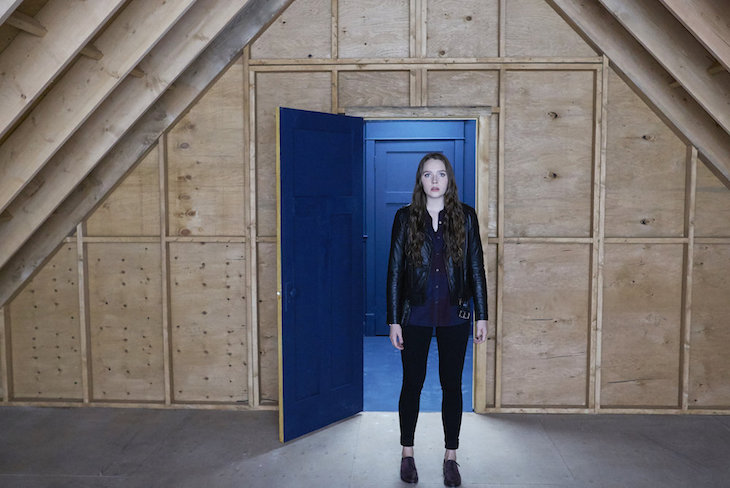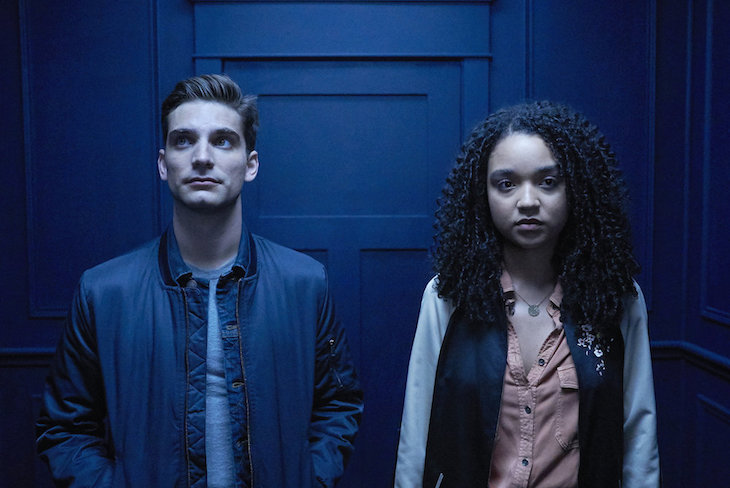It’s that time of year when horror rules cineplexes and living rooms, as evidenced by a certain clown ravaging box office records. In the midst of its 25th anniversary, Syfy hopes it can create its own fear-filled phenomenon with Channel Zero: No-End House, the second season of its horror anthology series.
Inspired by “creepypastas,” user-generated horror stories that have gone viral, the series comes from creator and executive producer Nick Antosca (Teen Wolf, Hannibal).
In advance of the second-season premiere, Daily Brief chatted with Antosca about the anthology format, the charm of Winnipeg, and finding the time to write.
Daily Brief: When are you most productive writing?
Nick Antosca: 2:15 in the morning. To about 5 in the morning.
Do you plan for that?
Sometimes. When possible. When we’re in production, the actual answer is anytime I can grab twenty or thirty minutes to write. The process of running a show requires an insane degree of multitasking, so the middle of the night is the time when I can sit down, focus and churn out some pages.
What’s it like working on a show that already has a third and fourth season greenlit?
As a writer in TV, it’s not something you can count on. The knowledge that I can tell one story this season, and we’ve got another season coming, and I can tell a whole different story, it’s an unusual, creative gift that you don’t take for granted. In this industry we’re disciplined to like whatever time you get. To be able to plan ahead and creatively know you have somewhere to go, it’s really exciting and cool.
What do you love about the anthology format? Are there any drawbacks?
I wouldn’t say there are any drawbacks to it. The challenge is that the train’s always moving. Right now, we have one season that’s premiered, we just finished shooting another season, we’re writing the next season, so there’s a lot of things going on. I find that stimulating and exciting. You never get to turn your brain off. The thing I like most is that we’re basically making a six-hour movie every nine or ten months. That’s just not an opportunity you get, ever. I hope we get many more seasons, but just having four is incredible.
Do you feel like you have to up the ante in season 2?
Up the ante is the wrong idea. Because we base each season on a totally different story and we have a different director do the entire season, it means we get to do something new every season. The challenge is to have a certain standard. We want something psychologically interesting, and something with a consistent and compelling atmosphere of dread. But we also want it to feel different from the previous season. We want it to feel like a different flavor. We also want it to be a showcase for an exciting new director each season. No-End-House is going to feel different from Candle Cove.
How is Channel Zero a showcase for new directors?
First of all, selfishly, I see this show as an opportunity to work with people who I admire creatively, who I’m excited about, who I’ve been a fan of.
The first season, Craig [William Macneill’s] film The Boy was a beautiful, interesting, disturbing film that represents a strong, specific vision. But it’s not something that a TV executive would look at and be like, we have to hire this guy to come do episodic TV. I made the case to Syfy, and fortunately they were very receptive. And that’s what set the standard.
I searched far and wide to find the right director for No-End House. I must’ve watched a hundred movies. I saw Steven Piet’s film Uncle John on Netflix and this movie was made for like 100 grand or something and you could just see he’s got the skills and the vision, and I really wanted to work with him.
There’s also people like Sarah Sitkin, this sculptor who’s out of LA, who’s an interesting artist. She does the sculptures in No-End House, and helped us conceptualize a lot of other things, like the flesh memories.
Guy Maddin, an indie filmmaker who I’ve been a fan of for a long time, created the teasers for No-End House. He’s a local Winnipeg director actually.
This season felt very much in line with the experiential haunted house craze and escape rooms. Are you into those?
It’s not like I go all the time. I’ve been to some stuff here and there. “Sleep No More” is explicitly one of the inspirations for our version of the No-End House. In the original story, which we stuck to the outlines of, the house is a more of a Halloween Horror Nights kind of haunted house. We wanted to take that idea and evolve it into an interactive, sinister art installation that would manipulate the psychology of those who go into it. That’s one reason why we wanted to have real artists come in and work with us on designing the house.
A lot of the cast would go off on the weekend and go to escape rooms in Winnipeg. It was in the air and on everyone’s minds.
What’s the best thing to do in Winnipeg?
I mean…there isn’t that much to do. Don’t print that. I love Winnipeg. There are actually a lot of escape rooms there. It’s kind of a big escape-room culture for some reason. We shot every season there so far, including the third one, which we just wrapped. It’s kind of my home away from home now. I just got back to LA. I kind of miss the food in Winnipeg, believe it or not.
What’s the food like?
It’s this weird cross between midwestern, Polish and like Asian fusion.
That could be a horror movie in itself.
Winnipeg is very Lynchian. It’s drab and quiet. But it can look like almost anywhere in America. Candle Cove looks totally different from No-End House but we shot them in the same place.

What inspired you to use creepypastas as source material?
I’ve been a fan of creepypastas for a long, long time. They feel like part of the collective unconscious in a way that urban legends are. Basically they’re the modern urban legends. They’re this huge horror resource that nobody has tapped into. They have this fanbase, for whom they strike a chord, and people do fanfiction of them. They do fan-made video games. They write unauthorized sequels to their favorite stories. All kinds of stuff like that.
Clearly this stuff touches a nerve out there. The original idea was to adapt Candle Cove into a miniseries. But I was like, there’s so many stories out there, and the best ones have tremendous potential. What if we do a thing where we do a different story every year? Syfy was really responsive to that.
Why is the horror genre important in today’s world, which feels so full of horror already?
Horror gives us a medium to speak explicitly about fears in our daily lives or relationships. The Exorcist is really about a woman who’s afraid her daughter is growing up. Rosemary’s Baby is about a woman who doesn’t trust her husband. The Shining is about an abusive father. When we’re culturally, nationally terrified of what’s going to happen to us, horror can be a powerful way to express the cloud of dread that hovers us. A way to deal with it, and try to understand it.
That feeling, with everything that’s going on now, expresses itself in all kinds of art, and pervades our daily lives. We were shooting No-End-House during the election and it definitely pervaded the atmosphere on set. Even though most of the people there were Canadian, we were obsessively watching or reading. We were shooting the sex scene at the end of episode 3 on the night of the election, as the results were coming in. Jeff Ward, who plays Seth, was freaking out. As was I. Between takes we’d be like, oh my god, what’s happening?
No-End-House feels like it’s about grief and loss.
Absolutely. Even though Candle Cove and No-End-House are quite different on the surface, they’re both about a main character dealing with the death of a loved one. And they deal with it in radically different ways. Season 1 and season 2 are thematic companion pieces.

What are your horror influences?
As a little kid, a couple key things that influenced me. Especially Night of the Living Dead. I was particularly affected when [George A.] Romero died earlier this year. I saw that movie when I was 8 or 9. I went in the backyard and started playing Night of the Living Dead with my legos. That was probably the thing that made me want to write, tell stories, whatever.
Each season of Channel Zero exists in a different horror zone. Candle Cove is very Stephen King. No-End House is John Carpenter meets Solaris. Season 3 is more like Dario Argento. There’s horror influences from all different neighborhoods of the genre in future seasons.
The next season of Channel Zero premieres Wednesday September 20 at 10 p.m. ET on Syfy.
Tags:













































__twocolumncontent.jpg)











